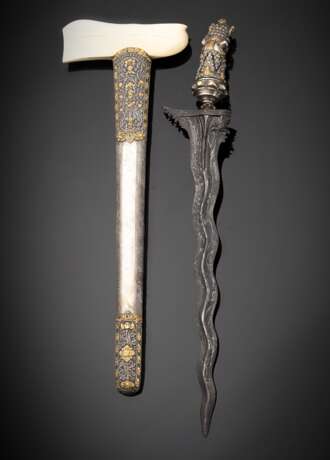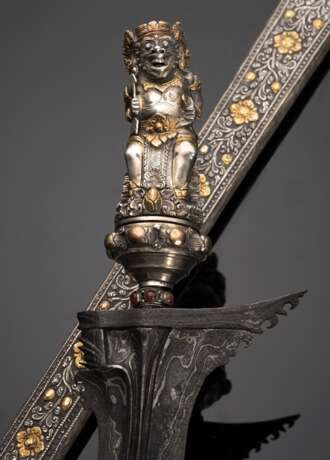ID 1218060
Lot 1543 | Keris
Estimate value
€ 2 800 – 3 500
L. 60 cm
Aufwendige, gut erhaltene Klinge, gewellt mit mäßiger Amplitude (11 Wellen, luk) mit rudimentärem sekar kajang und mit paarigen geschwungenen Doppelgruben sogokan. Die Form wird wegen der kraftvollen, etwas martialischen als bhima krodha (wütender Bima; hinduistische Heldengestalt aus dem Epos Mahabharata) bezeichnet. Die Form wird traditionell mit maskuliner Vitalität assoziiert. Hohlgeschabte Flanken (kruwingan), pamor (Schmiedemuster) beras wutah, erhabener Grat ada-ada („Rücken“; Rückgrat), ungesteuertes Lagenbild (beras wutah) auf beiden Seiten der slorok (Stahlkern). Aus Silber getriebener Griff in deling-Form oder togokan (togok = Statue), teilweise feuervergoldet, darstellend eine dämonische Gottheit, i.d.R. als Buta Nawasari (buta = Dämon) bezeichnet. Die linke Hand vollführt eine mudra (Geste), leicht geneigte lalita-Haltung; mit Tendenz zur Droh-/Abwehrgebärde. In der rechten Hand hält sie ein Waffen-Attribut. Selut mit imitierten Steinfassungen, „Steine“ als Metallkappen, integral mit der selut. Mendak (Fassung) mit roten Cabochons. Die Scheide mit kastenförmigem Mundstück aus Elefanten-Elfenbein in kandik- (Beil-)Form, die gandar (Klingenscheide) ist mit floral getrie-bener, teil-feuervergoldeter Silberblech-Kappe (javan. pendok) versehen. Die Grifffigur verweist ikonografisch auf den javanischen Tantrismus des 12 - 14. Jh. Die Ursprünge des Hindu-Tantra liegen in verschiedenen Einflüssen des frühen Mittelalters in Indien. Diese sind die südost-asiatische dämonologische Tradition eingeflossen, lokale und volkstümliche Einflüsse hatten Einfluss auf religiöse Sekten wie die Pashupata, die neue religiöse Rituale und Lehren einführten, die nicht-arisch-vedisch waren. Das mittelalterliche Tantra diente häufig dazu, einen König, der aus niederen Kasten stammte oder ausländischer Herkunft war, durch Rituale zu legitimieren, die ihm im vedisch-orthodoxen Ritual nicht zugänglich waren. Auf diesem Wege sind in das Hindu-Tantra Praktiken eingeflossen, die die rituelle Transformation des Praktizierenden in einen Gottkönig zum Ziel haben, der ein Pantheon von Göttern und Dämonen regiert und dessen Palast in der Mitte des Mandalas angesiedelt ist. Schönes, geschlossenes Ensemble, Montierung in der „barocken“ Tradition von Ubud und Badung.
Aus einer alten deutschen Privatsammlung, seit den 1950er Jahren gesammelt - Minim. Altersspuren
Lit.: Ramseyer, U. (1977): Bali. Leben in zwei Welten. Zürich. - IFICAH (2015): Götter-Schmiede. Balinesische Zeremonialklingen im kulturellen Kontext. Wohlesbostel. - Neka, P.W.S. (2010): Keris Bali Bersejarah. Neka Art Museum, Ubud.
| Auction house category: | Ethnographic tribal art |
|---|
| Auction house category: | Ethnographic tribal art |
|---|
| Address of auction |
Nagel Auktionen GmbH Neckarstrasse 189 - 191 70190 Stuttgart Germany | ||||||||||||||
|---|---|---|---|---|---|---|---|---|---|---|---|---|---|---|---|
| Preview | |||||||||||||||
| Phone | +49 (0)711 649 690 | ||||||||||||||
| Fax | +49 (0)711 649 69696 | ||||||||||||||
| Buyer Premium | 29,5% | ||||||||||||||
| Conditions of purchase | Conditions of purchase | ||||||||||||||
| Business hours | Business hours
|





